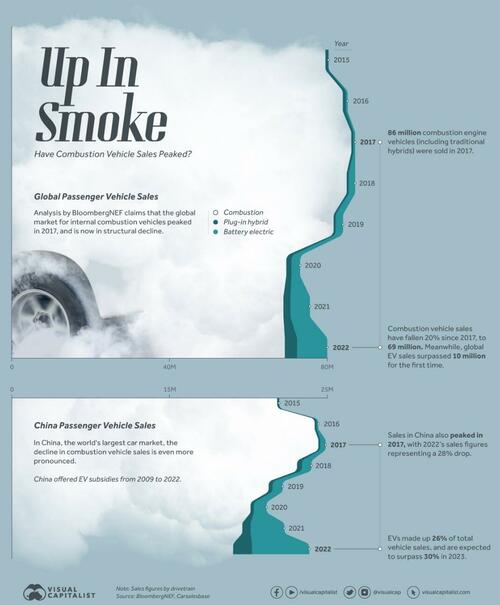Have Internal-Combustion-Engine Vehicle Sales Already Peaked?
Electric vehicle (EV) sales have grown rapidly over the past few years, but have they managed to make a dent in the global market?
To find out, Visual Capitalist's Marcus Lu visualized data from BloombergNEF that breaks down annual vehicle sales by three categories:
-
Internal combustion (including traditional hybrids)
-
Plug-in hybrids
-
Battery electric
From this, we can see that EVs are definitely building up market share. In fact, combustion vehicle sales appear to have peaked in 2017.
Growth in EV Market Share
The following table lists global EV sales, as well as their relative market share.
| Year | EV Sales | EV Market Share (%) |
|---|---|---|
| 2013 | 206,000 | 0.2 |
| 2014 | 320,000 | 0.4 |
| 2015 | 543,000 | 0.6 |
| 2016 | 791,000 | 0.9 |
| 2017 | 1,262,000 | 1.3 |
| 2018 | 2,082,000 | 2.2 |
| 2019 | 2,276,000 | 2.5 |
| 2020 | 3,244,000 | 4.2 |
| 2021 | 6,768,000 | 8.3 |
| 2022 | 10,522,000 | 13.0 |
*Includes plug-in hybrids. Source: EV Volumes
We can see that EV sales really picked up steam around 2019. This is likely due to various government subsidies and a growing list of models to choose from.
EV ranges, once a major limiting factor, are also becoming less of a concern as battery technology improves and more charging stations become available.
Will Combustion Vehicle Sales Stage a Comeback?
It seems unlikely that combustion vehicles will be able to reclaim much of their lost market share.
China, the world’s largest car market, is leading the world in terms of EV adoption. As of 2022, one in four new cars sold in the country is electric. The U.S. and EU are transitioning slower, but should catch up thanks to government subsidies and a planned phase-out of fossil fuel vehicles.
In the EU, the sale of new internal combustion vehicles will be banned by 2035. However, an exemption was recently made on behalf of Germany to allow the sale of cars that run on synthetic fuels.
In the U.S., the 13 states that adhere to California’s Zero Emissions Vehicle (ZEV) Program are aiming for 100% of cars sold in 2035 to be ZEVs. These states include California, Colorado, Connecticut, Maine, Maryland, Massachusetts, Minnesota, New Jersey, New York, Oregon, Rhode Island, Vermont, and Washington.
https://ift.tt/ihDnWuB
from ZeroHedge News https://ift.tt/ihDnWuB
via IFTTT





0 comments
Post a Comment